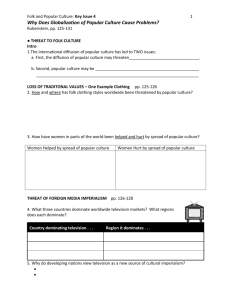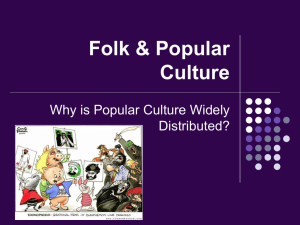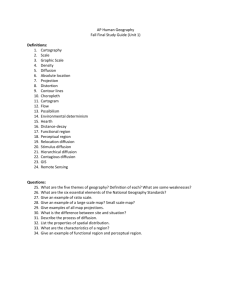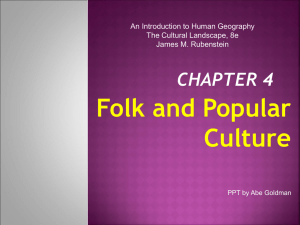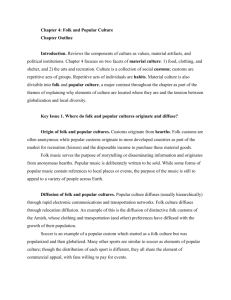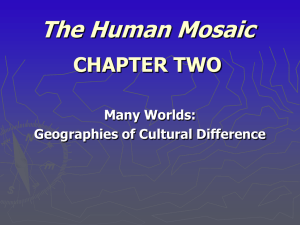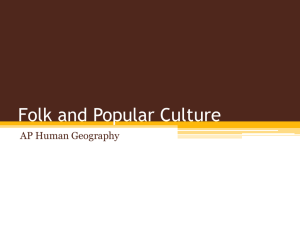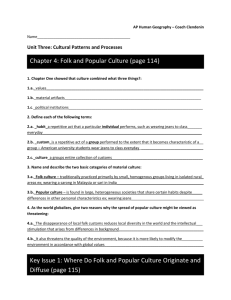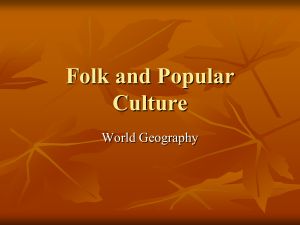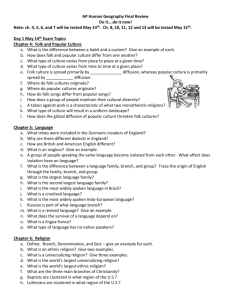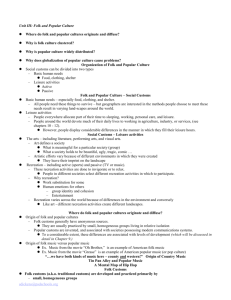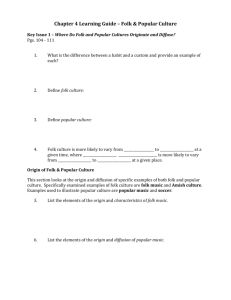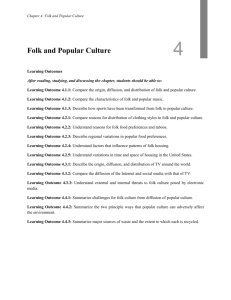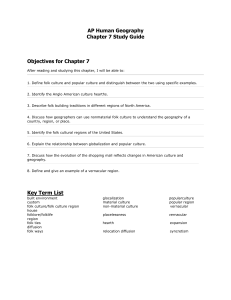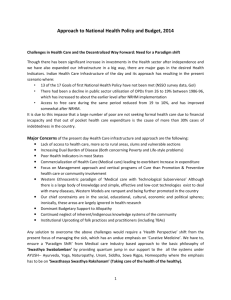AP Ch_ 4 GR - Collierville High School
advertisement
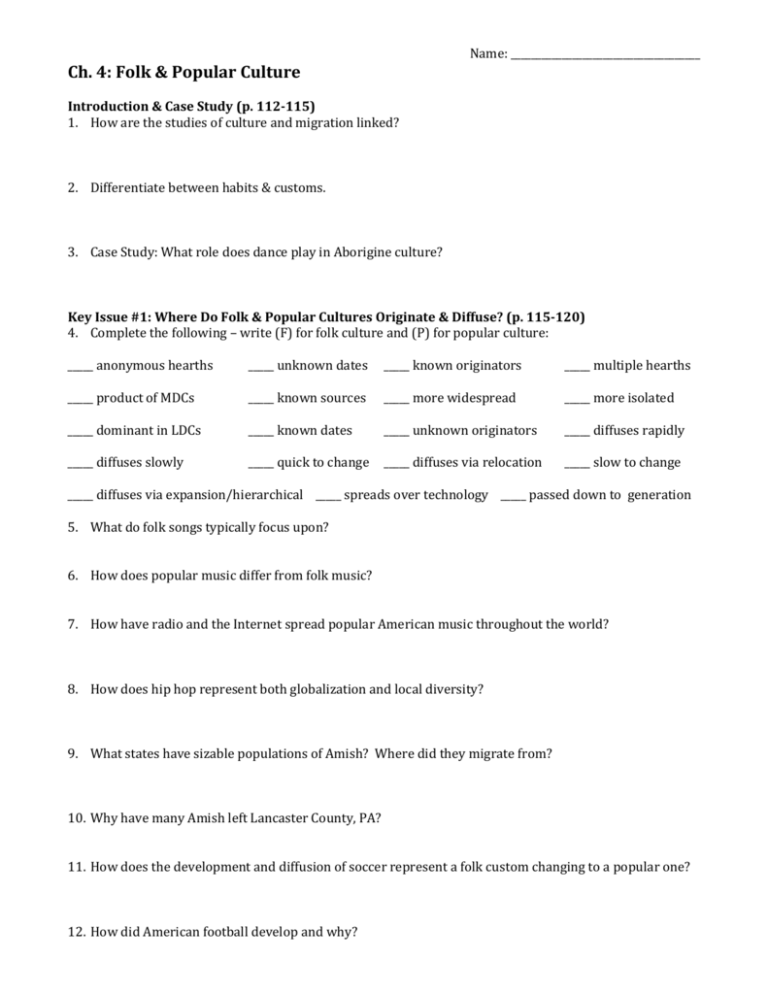
Name: _____________________________________ Ch. 4: Folk & Popular Culture Introduction & Case Study (p. 112-115) 1. How are the studies of culture and migration linked? 2. Differentiate between habits & customs. 3. Case Study: What role does dance play in Aborigine culture? Key Issue #1: Where Do Folk & Popular Cultures Originate & Diffuse? (p. 115-120) 4. Complete the following – write (F) for folk culture and (P) for popular culture: _____ anonymous hearths _____ unknown dates _____ known originators _____ multiple hearths _____ product of MDCs _____ known sources _____ more widespread _____ more isolated _____ dominant in LDCs _____ known dates _____ unknown originators _____ diffuses rapidly _____ diffuses slowly _____ quick to change _____ diffuses via relocation _____ slow to change _____ diffuses via expansion/hierarchical _____ spreads over technology _____ passed down to generation 5. What do folk songs typically focus upon? 6. How does popular music differ from folk music? 7. How have radio and the Internet spread popular American music throughout the world? 8. How does hip hop represent both globalization and local diversity? 9. What states have sizable populations of Amish? Where did they migrate from? 10. Why have many Amish left Lancaster County, PA? 11. How does the development and diffusion of soccer represent a folk custom changing to a popular one? 12. How did American football develop and why? 13. Why is ice hockey popular in Canada & Russia? Why is baseball popular in Japan? Key Issue #2: Why Is Folk Culture Clustered? (p. 120-126) 14. What role does physical isolation play in culture? 15. How do the paintings of various religious groups in the Himalayas differ in their views of the surrounding environment? 16. How have some folk cultures adapted their clothing styles to their environments? 17. How can the environment affect food customs? Give some examples. 18. How can cultural traditions affect food customs, such as those in Transylvania? 19. Give examples of foods that have perceived desirable qualities to various cultures. 20. What is a taboo? Give examples of non-religious food taboos. 21. Give examples of food taboos based on religious beliefs. 22. Discuss the values of eating insects versus its taboo in U.S. culture. 23. Describe how a combination of environmental & social factors may contribute to choices of building materials. 24. How might religious beliefs and social customs affect the orientation of houses & room arrangement? 25. How do environmental factors influence house shapes or orientation? 26. Describe the diffusion of various U.S. folk housing forms. Why are folk houses no longer the norm in the U.S.? Key Issue #3: Why Is Popular Culture Widely Distributed? (p. 126-135) 27. What does a study of U.S. popular housing styles inform us about how popular customs vary? 28. How did the ranch style house encourage sprawl? How did the garage & family room of the split-level house represent changing customs of the time? 29. What 2 factors influence popular clothing styles? 30. What has facilitated the rapid diffusion of fashion? 31. How have folk clothing styles been adapted into popular fashion? 32. How have jeans transitioned from folk culture to popular culture? 33. How did jeans and other Western products contribute to the fall of communism in the Soviet Union & Eastern Europe? 34. How do snacks and alcohol consumed in different U.S. regions vary? How might religion play a role? 35. Complete the following chart to describe ideal conditions for grape/wine production: Temperature/Seasons Precipitation/Seasons Terrain Water Access Soil 36. What role might cultural values & religious beliefs play in wine production or consumption? 37. Why is watching TV an important popular custom? 38. Trace the diffusion of TV ownership worldwide since WWII. 39. In what ways has Internet diffusion been similar and different than TV diffusion? 40. How is control of TV stations different in the U.S. than much of the world? 41. How has satellite technology affected government control of TV? What have some Asian countries done do reduce the impact of satellite dishes? 42. What other technologies serve as a threat to government control of information? Key Issue #4: Why Might the World Face an Overpopulation Problem? (p. 135-141) 43. Why do people fear the diffusion of popular culture? 44. How has adoption of popular clothing led to conflict in LDCs? How did this play out in Iran in 1997? 45. What is the traditional role of women as found in many folk societies? 46. How have the Taliban restricted the role of women in Afghanistan? 47. In what ways do men in MDCs continue to exploit women? 48. Who controls the TV industry in LDCs? Why does this upset many leaders of LDCs? 49. What 2 agencies control most of the news media worldwide? 50. What impacts have marriage dowries had on India? 51. How does popular culture affect the environment differently than folk culture? 52. What is a uniform landscape AND why is it important to popular customs and their diffusion? 53. Discuss the positives & negatives of chain restaurants and stores. 54. How has Japanese auto-making changed since the 1970s? 55. How has popular culture hurt natural resources and animal populations? 56. Describe why meat consumption is inefficient. 57. How does popular culture pollute and harm the environment? 58. How may folk cultures also pollute and harm the environment? 59. Case Study Revisited: How did Australia nearly destroy Aborigine culture?
